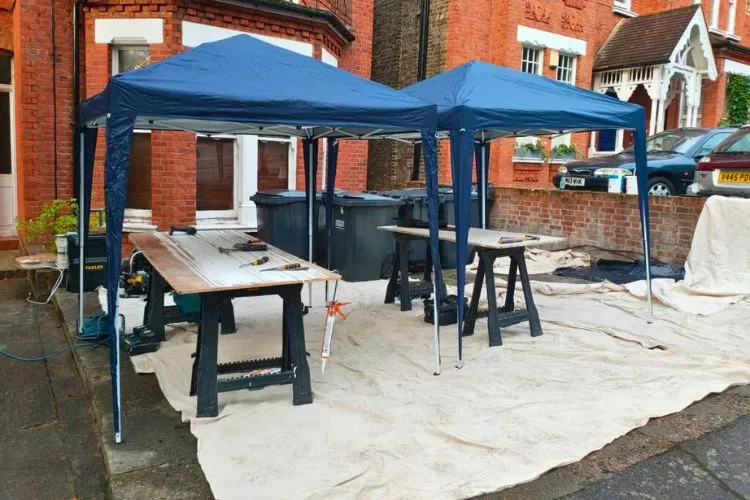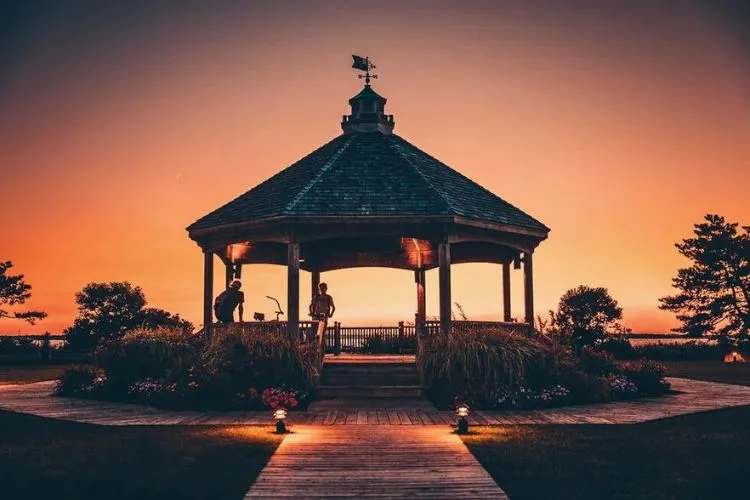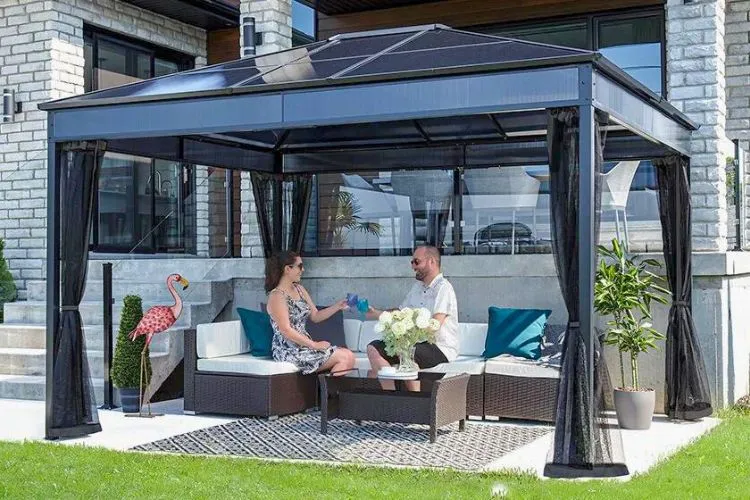Gazebos offer a serene and versatile outdoor space that can transform any yard or garden. However, one common challenge that gazebo owners face is the sides of the gazebo flapping in the wind.
This not only disrupts the peace but can also lead to wear and tear if not addressed. To help tackle this challenge, this article delves into how to stop gazebo sides from flapping.

Contents
- 1 Understanding Gazebo Dynamics
- 2 Essential Tools and Materials
- 3 Preventive Measures
- 4 How To Stop Gazebo Sides From Flapping?
- 5 Advanced Solutions
- 6 Safety Considerations
- 7 Maintenance and Care
- 8 Different Types of Gazebo Side Materials
- 9 Frequently Asked Questions (FAQs)
- 9.1 How can I tell if my gazebo can withstand strong winds?
- 9.2 What are the most cost-effective ways to stop gazebo sides from flapping?
- 9.3 Can I secure the sides of my gazebo without affecting its aesthetic appeal?
- 9.4 How do I maintain the functionality of my gazebo sides while ensuring they don’t flap?
- 9.5 Are there any temporary fixes for stopping gazebo sides from flapping during an unexpected gust of wind?
- 9.6 How often should gazebo sides be replaced to prevent flapping due to material fatigue?
- 9.7 What are the best practices for securing a gazebo in areas with frequent high winds?
Understanding Gazebo Dynamics
Wind can have a significant impact on light structures such as gazebos. The material used for gazebo sides is usually lightweight to maintain the flexibility of the structure, which unfortunately makes it susceptible to flapping in breezy conditions.
Recognizing how wind interacts with these materials is critical in finding the right solution to mitigate its effects.
Essential Tools and Materials
Securing gazebo sides requires a few tools and materials, such as velcro straps, weights, anchoring systems, snap-on buttons, zippers, elastic bungee cords, and sometimes, heavier material for side panels. These items are essential for implementing the solutions discussed below.
Preventive Measures
Securely installing gazezebo sides during the initial setup is crucial. Ensure that each panel is tightly fastened to the frame, leaving minimal room for wind to catch.

Regular maintenance checks are also vital. These involve periodic inspections for signs of wear and tear or any loose components that could contribute to flapping.
How To Stop Gazebo Sides From Flapping?
Securing Sides to the Frame
Using velcro straps, snap-on buttons, or zippers can significantly reduce flapping. These fasteners allow for a secure attachment of the gazebo sides to the frame, minimizing movement in windy conditions.
Adding Weights
Weights at the gazebo’s base can offer stability. Leg weights or sandbags provide a simple yet effective means of anchoring the gazebo. For those preferring a DIY approach, filling old socks with sand or rocks can serve as a makeshift solution.
Reinforcing Corners and Edges
Elastic bungee cords, tethers, or stakes can reinforce the gazebo’s corners and edges, providing added resistance against the wind. This method secures the lower parts of the gazebo sides, distributing tension and reducing flapping.
Implementing Wind Panels
Wind panels or a wind bar can shield the gazebo from direct wind pressure. Installing these items helps to redirect airflow over and around the structure rather than through it, which can significantly reduce flapping.
Advanced Solutions
For areas that experience severe weather conditions, upgrading to heavier and more durable materials for gazebo sides may be necessary.
Additionally, converting the gazezebo into a more permanent structure with fixed sides can offer a long-term solution to the problem of flapping.
Safety Considerations
It is important to understand the limitations of your gazebo. Recognizing wind thresholds is critical and the sides of the gazebo should be taken down during severe weather to prevent damage. Ensuring that the gazebo sides remain accessible as exits in case of emergencies is also vital.
Maintenance and Care
Proper maintenance and care of gazebo sides are key to their longevity. Cleaning, drying, and storing the side panels properly when not in use can prevent damage.
Regular upkeep schedules can help ensure that the gazebo remains a durable and welcoming outdoor space.
Different Types of Gazebo Side Materials
When selecting materials for gazebo sides, understanding their properties can help balance functionality, aesthetics, and wind resistance.

Canvas: Known for its durability and traditional look, canvas offers great protection from the elements. However, its heavyweight can make handling difficult, and it may require more support to prevent flapping in strong winds.
Polyester: A popular choice due to its lightweight and versatile nature, polyester is easy to manage and available in various densities. While it offers moderate wind resistance, its lightweight nature means it may need additional anchoring in high wind areas.
PVC-Coated Fabric: This material provides excellent waterproofing and wind resistance, making it ideal for harsh weather conditions. The downside includes its heavier weight and the potential for reduced breathability, which could affect comfort under the gazebo.
Mosquito Netting: While excellent for bug protection and offering good air circulation, mosquito netting is the least resistant to wind. It can tear easily if not supported properly during windy conditions, requiring careful installation with additional windproof measures.
Material choice directly impacts a gazebo’s wind resistance, requiring a balance between functionality, maintenance, and the specific weather conditions of an area.
Frequently Asked Questions (FAQs)
How can I tell if my gazebo can withstand strong winds?
Assess the weight, materials, and anchoring system of your gazebo. Heavy-duty materials and secure anchoring indicate higher wind resistance.
What are the most cost-effective ways to stop gazebo sides from flapping?
Using DIY weights and ensuring proper installation are cost-effective strategies.
Can I secure the sides of my gazebo without affecting its aesthetic appeal?
Yes, many solutions like discreet velcro straps or clear bungee cords offer practicality without compromising on aesthetics.
How do I maintain the functionality of my gazebo sides while ensuring they don’t flap?
Utilize detachable fasteners like velcro or snap-on buttons that allow easy removal or opening of the sides when needed.
Are there any temporary fixes for stopping gazebo sides from flapping during an unexpected gust of wind?
Temporary solutions include quickly attaching heavy items at the base or using clamps to hold the sides down.
How often should gazebo sides be replaced to prevent flapping due to material fatigue?
Check for signs of wear annually and consider replacement every 3-5 years, depending on material quality and maintenance.
What are the best practices for securing a gazebo in areas with frequent high winds?
Opt for heavy-duty materials, permanent anchoring solutions, and consider installing wind deflectors.
Conclusion:
Securing the sides of a gazebo not only enhances the comfort and usability of the space but also contributes to the structure’s longevity. By understanding the dynamics of wind and gazebo materials, and implementing the solutions provided, you can significantly reduce or eliminate flapping.
Regular maintenance and a proactive approach to securing the gazebo will ensure that this outdoor haven remains a place of serenity and joy, regardless of the weather.
By addressing the common issue of gazebo sides flapping with practical and effective solutions, you can ensure your outdoor space remains comfortable and functional, even in windy conditions. This guide offers a comprehensive approach, from preventative measures to advanced solutions, ensuring your gazezebo is well-protected and enjoyed for years to come.

Sergio Gomes, a passionate advocate for outdoor living and the male voice behind Shades Authority. With years of experience, Sergio is your trusted source for expert insights on gazebos, pavilions, cabanas, pergolas, and all things outdoor shade solutions. Join him on a journey to transform your outdoor spaces into stunning, functional retreats
